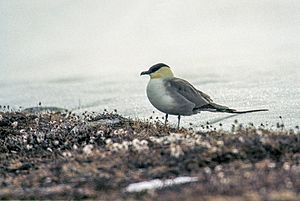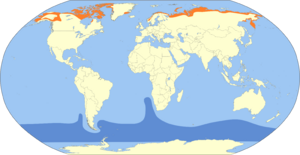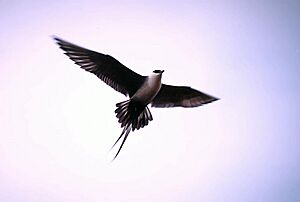Long-tailed jaeger facts for kids
Quick facts for kids Long-tailed jaeger |
|
|---|---|
 |
|
| Conservation status | |
| Scientific classification | |
| Genus: |
Stercorarius
|
| Species: |
longicaudus
|
 |
|
The long-tailed skua or long-tailed jaeger (Stercorarius longicaudus) is a fascinating seabird. It belongs to the skua family, called Stercorariidae. These birds are known for their long tail feathers, especially during summer.
Contents
What's in a Name?
The word "jaeger" comes from the German word Jäger. This word means "hunter." It's a good name because these birds are skilled hunters!
The name "skua" comes from the Faroese language. It's from the word skúgvur, which is what people on the Faroe Islands call the great skua. There's even an island called Skúvoy known for these birds!
The scientific name, Stercorarius longicaudus, also tells us something. Stercorarius is Latin and means "of dung." This is because people once thought the food skuas stole from other birds was actually waste. Longicaudus is also from Latin. It means "long tail," which perfectly describes this bird!
How to Spot a Long-tailed Skua
Adult long-tailed skuas are easy to recognize. They have a grey back and dark feathers on their wings. They also have a black cap on their head and a very long tail. When they are breeding, adults often hover over their nests.
Younger birds, called juveniles, are harder to identify. They look a lot like another bird, the parasitic jaeger, especially when flying over the ocean. However, long-tailed skuas are usually slimmer and have longer wings. They also look more like a tern bird. Their feathers are often greyer, not as brown as the Arctic skua.
This is the smallest bird in the skua family. It measures about 38 to 58 centimeters (15 to 23 inches) long. But wait, up to 29 cm (11 inches) of that length can be just its tail! The long tail streamers of a summer adult can be 15 cm (6 inches) long. These birds have a wingspan of 102 to 117 cm (40 to 46 inches). They weigh between 230 and 444 grams (8 to 16 ounces).
Different Types of Long-tailed Skuas
There are two main types, or subspecies, of the long-tailed skua:
- S. l. longicaudus: This type is found in northern Scandinavia and Russia.
- S. l. pallescens: This type lives in eastern Siberia, the Arctic parts of North America, and Greenland.
Reproduction and Habitat

Long-tailed skuas make their homes in the high Arctic regions. You can find large groups in Russia, Alaska, and Canada. Smaller groups live in other parts of the Arctic.
These birds are migratory. This means they travel long distances. They spend their winters far away in the southern Atlantic and Pacific oceans. Young birds sometimes hunt for small animals in fields or on golf courses during their journey. They are usually not afraid of people.
They build their nests on dry tundra or higher hills. A female skua usually lays two olive-brown eggs with spots. When they are on their breeding grounds, you might hear them making yelping or rattling sounds. When they are out over the ocean, they make a harsh kreeah cry.
These birds eat different kinds of food. They catch fish, often by taking it from other seabirds. They also eat smaller birds, food scraps, small mammals, fruit, and even dead animals (called carrion). When they are migrating, long-tailed jaegers are more likely to catch their own food. They are less likely to steal from gulls and terns compared to larger skua species.




